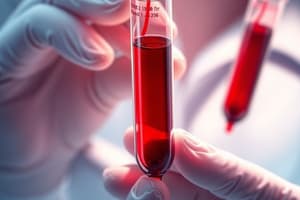Podcast
Questions and Answers
What is the primary reason for collecting blood specimens in the correct order of draw?
What is the primary reason for collecting blood specimens in the correct order of draw?
- To avoid cross-contamination between different tube additives. (correct)
- To reduce the time taken during the blood collection process.
- To ensure that samples can be inverted multiple times.
- To simplify the labeling process for each tube.
Which tube color requires the highest number of inversions after collection?
Which tube color requires the highest number of inversions after collection?
- Red Top (plastic)
- Gray Top (correct)
- Light Blue Top
- Lavender/Purple/Pink Top
What should be checked against a patient's identification bracelet after labeling a blood collection tube?
What should be checked against a patient's identification bracelet after labeling a blood collection tube?
- The tube color and type.
- The collection site's location.
- The patient's age and weight.
- The labeled information on the tube. (correct)
Which of the following tubes is considered as the first tube to be collected when adhering to the order of draw?
Which of the following tubes is considered as the first tube to be collected when adhering to the order of draw?
Which statement accurately describes a non-additive blood collection tube?
Which statement accurately describes a non-additive blood collection tube?
What anticoagulant does the Pink Top tube contain for blood bank studies?
What anticoagulant does the Pink Top tube contain for blood bank studies?
Which blood collection tube color is typically used for coagulation tests?
Which blood collection tube color is typically used for coagulation tests?
What is one of the risks associated with using plastic serum tubes that contain clot activators?
What is one of the risks associated with using plastic serum tubes that contain clot activators?
What could cause a falsely high RBC count?
What could cause a falsely high RBC count?
Which type of error can lead to a falsely low MCH value?
Which type of error can lead to a falsely low MCH value?
What is a probable reason for a falsely high Mean Cell Volume (MCV)?
What is a probable reason for a falsely high Mean Cell Volume (MCV)?
Which parameter is falsely low due to hemolysis in vitro?
Which parameter is falsely low due to hemolysis in vitro?
Which of the following can lead to a falsely low Mean Cell Hemoglobin Concentration (MCHC)?
Which of the following can lead to a falsely low Mean Cell Hemoglobin Concentration (MCHC)?
What probable reason could result in a falsely high hematocrit reading?
What probable reason could result in a falsely high hematocrit reading?
Which type of error can contribute to a falsely high Mean Cell Hemoglobin (MCH)?
Which type of error can contribute to a falsely high Mean Cell Hemoglobin (MCH)?
What is a probable reason for falsely low hematocrit readings?
What is a probable reason for falsely low hematocrit readings?
What could cause a falsely high reading in Hemoglobin testing?
What could cause a falsely high reading in Hemoglobin testing?
Which condition is likely to cause a falsely low WBC count?
Which condition is likely to cause a falsely low WBC count?
What is a potential reason for a falsely elevated Platelet Count?
What is a potential reason for a falsely elevated Platelet Count?
Which of the following could influence the Mean Platelet Volume (MPV) to yield a falsely high result?
Which of the following could influence the Mean Platelet Volume (MPV) to yield a falsely high result?
Which factor is most likely to produce a falsely low reading in Lymphocyte count?
Which factor is most likely to produce a falsely low reading in Lymphocyte count?
What is a common cause for falsely low Neutrophil readings?
What is a common cause for falsely low Neutrophil readings?
In which scenario would Eosinophil counts likely be falsely elevated?
In which scenario would Eosinophil counts likely be falsely elevated?
Which factor is linked to a falsely high Neutrophil count?
Which factor is linked to a falsely high Neutrophil count?
What is the primary action that must be taken when a critical value is obtained?
What is the primary action that must be taken when a critical value is obtained?
Which of the following critical value thresholds is correctly stated?
Which of the following critical value thresholds is correctly stated?
What should be done if platelet satellitosis is observed during an EDTA blood smear?
What should be done if platelet satellitosis is observed during an EDTA blood smear?
How is the correction for falsely low platelet counts computed when platelet satellitosis occurs?
How is the correction for falsely low platelet counts computed when platelet satellitosis occurs?
What is one of the benefits of using EDTA for blood smears?
What is one of the benefits of using EDTA for blood smears?
What is the main issue that resulted in the patient's initial low platelet count in the case study?
What is the main issue that resulted in the patient's initial low platelet count in the case study?
Which statement accurately describes a common misunderstanding about pseudothrombocytopenia?
Which statement accurately describes a common misunderstanding about pseudothrombocytopenia?
What adjustment should be made to accurately retest the platelet and leukocyte counts following pseudothrombocytopenia?
What adjustment should be made to accurately retest the platelet and leukocyte counts following pseudothrombocytopenia?
Which outcome does not correctly reflect the expected results after using the 3.2% sodium citrate tube?
Which outcome does not correctly reflect the expected results after using the 3.2% sodium citrate tube?
Which method is predominantly used in blood film preparation and involves a specific angle between slides?
Which method is predominantly used in blood film preparation and involves a specific angle between slides?
Flashcards
Blood Collection Order
Blood Collection Order
Specific sequence for drawing blood samples to avoid contamination between different specimens and potential additive carryover.
Order of draw
Order of draw
The recommended sequence for collecting blood samples to reduce contamination and ensure accurate test results.
Additive carryover
Additive carryover
Contamination of a blood sample with substances from a previous tube, leading to inaccurate lab results.
Blood culture tube
Blood culture tube
Signup and view all the flashcards
Citrated tube
Citrated tube
Signup and view all the flashcards
Serum tube (non-additive)
Serum tube (non-additive)
Signup and view all the flashcards
Heparinized tube
Heparinized tube
Signup and view all the flashcards
EDTA tube
EDTA tube
Signup and view all the flashcards
Sodium Fluoride tube
Sodium Fluoride tube
Signup and view all the flashcards
Gray Top Tube
Gray Top Tube
Signup and view all the flashcards
Tube Inversion
Tube Inversion
Signup and view all the flashcards
Labeling Standards
Labeling Standards
Signup and view all the flashcards
Falsely High RBC Count
Falsely High RBC Count
Signup and view all the flashcards
Falsely Low RBC Count
Falsely Low RBC Count
Signup and view all the flashcards
Falsely High MCV
Falsely High MCV
Signup and view all the flashcards
Falsely Low MCV
Falsely Low MCV
Signup and view all the flashcards
Falsely High MCH
Falsely High MCH
Signup and view all the flashcards
Falsely Low MCH
Falsely Low MCH
Signup and view all the flashcards
Falsely High MCHC
Falsely High MCHC
Signup and view all the flashcards
Falsely Low MCHC
Falsely Low MCHC
Signup and view all the flashcards
Falsely Low Hematocrit
Falsely Low Hematocrit
Signup and view all the flashcards
Falsely High Hematocrit
Falsely High Hematocrit
Signup and view all the flashcards
Falsely High Hemoglobin
Falsely High Hemoglobin
Signup and view all the flashcards
Falsely Low Hemoglobin
Falsely Low Hemoglobin
Signup and view all the flashcards
Falsely High WBC Count
Falsely High WBC Count
Signup and view all the flashcards
Falsely Low WBC Count
Falsely Low WBC Count
Signup and view all the flashcards
Falsely High Platelet Count
Falsely High Platelet Count
Signup and view all the flashcards
Falsely Low Platelet Count
Falsely Low Platelet Count
Signup and view all the flashcards
Falsely High Neutrophils
Falsely High Neutrophils
Signup and view all the flashcards
Falsely High Lymphocytes
Falsely High Lymphocytes
Signup and view all the flashcards
Critical Values
Critical Values
Signup and view all the flashcards
Hematocrit Critical Value
Hematocrit Critical Value
Signup and view all the flashcards
Platelet Critical Value (low)
Platelet Critical Value (low)
Signup and view all the flashcards
Prothrombin Time Critical Value
Prothrombin Time Critical Value
Signup and view all the flashcards
EDTA Blood Smear
EDTA Blood Smear
Signup and view all the flashcards
Pseudothrombocytopenia
Pseudothrombocytopenia
Signup and view all the flashcards
Platelet Satellitosis
Platelet Satellitosis
Signup and view all the flashcards
Correction for Pseudothrombocytopenia
Correction for Pseudothrombocytopenia
Signup and view all the flashcards
EDTA-induced platelet clumping
EDTA-induced platelet clumping
Signup and view all the flashcards
Pseudothrombocytopenia
Pseudothrombocytopenia
Signup and view all the flashcards
Platelet Clumping
Platelet Clumping
Signup and view all the flashcards
Pseudothrombocytopenia correction
Pseudothrombocytopenia correction
Signup and view all the flashcards
Two-glass slide method
Two-glass slide method
Signup and view all the flashcards
Angle between slides (smear)
Angle between slides (smear)
Signup and view all the flashcards
3.2% Sodium Citrate
3.2% Sodium Citrate
Signup and view all the flashcards
Blood Film Preparation
Blood Film Preparation
Signup and view all the flashcards
Study Notes
Reminders for Blood Specimen Collection
- Collect blood specimens using the correct order of draw to prevent cross-contamination from tube additives.
- Invert tubes containing additives immediately after collection.
- Label tubes appropriately with patient's full name, unique identification number, date and time of collection, phlebotomist's initials, and compare with patient's identification bracelet.
Order of Blood Draw
- Blood culture tube (Yellow Top) - 8 inversions
- Citrated tube (Light Blue Top) - 3-4 inversions
- Serum tube (Red Top glass) - 0 inversions
- Serum tube (Red Top plastic) - 5 inversions
- Heparinized tube (Green Top) - 8 inversions
- EDTA tube (Lavender/Purple/Pink Top) - 8 inversions
- Sodium fluoride tube (Gray Top) - 8 inversions
Other Blood Collection Tubes
- Black Top: Contains 3.8% sodium citrate, blood to anticoagulant ratio 4:1, used for Westergren ESR.
- Pink Top: Requires a special label, contains K2 EDTA, and can be used for a, 3.2% sodium citrate, or b, Citrate, Theophylline, Adenosine, Dipyridamole. Use cases include Blood Bank Studies and Whole blood Hematologic determinations.
- Light Blue Top: may contain either 3.2% sodium citrate or Citrate, Theophylline, Adenosine, Dipyridamole. Uses include coagulation tests, platelet factor 4, and beta-thromboglobulin assays, and in Gray platelet syndrome.
Studying That Suits You
Use AI to generate personalized quizzes and flashcards to suit your learning preferences.




